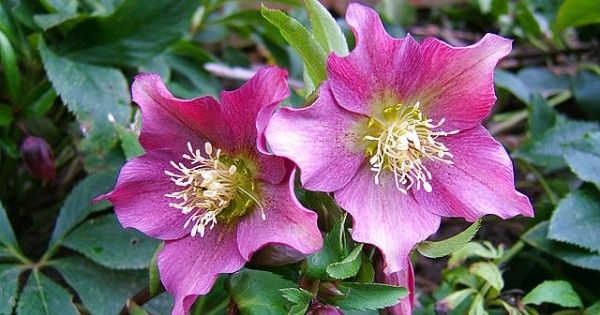
Mauve is a dusky sort of pinkish lavender that reminds me of lace and old ladies, don’t ask me why. It’s the exact color of the early blooming hellebores in my front yard. The color was introduced to the fashionistas of 1857 when Empress Eugenie of France, consort of Emperor Napoleon III, determined that a certain new synthetic dye matched her eyes. A further mauve moment came when Queen Victoria wore velvet of that color to her daughter’s wedding. This set off what Simon Garfield, in his book Mauve, calls mauve mania. It occurred during the era of the crinoline skirt, a garment ballooned by iron hoops to widths wider than doorways. These skirts required lots of fabric, good for the British textile industry. When dyed mauve, they required lots of mauve dye, good for a young chemist named William Henry Perkin.
Mauve was the color of the first synthetic dye. Made from coal, it was the first coal tar dye, and therefore the first aniline dye (aniline being a derivative of coal tar). Before mauve, dyes were made from plants, insects, and shellfish.
At the time, the 1850s, coal gas, which is largely methane, was used to light the streets of London. Manufacturing coal gas and the widely used fuel coke involved baking coal in a sealed oven, minus oxygen. The waste products were filthy water, coal tar, and sulfur compounds. The God-awful coal tar goo had no apparent use and was dumped into rivers and streams, where the fish promptly expired.
Coal is a rock composed of ex-plants, and at the core of coal and coal tar and organic chemistry is the carbon atom, hitched to the hydrogen atom, i.e., hydrocarbons. Various compounds can be gotten out of coal tar, which contains carbon, hydrogen, nitrogen, and oxygen. One of the big scientific efforts of the mid-19th century was to convert coal-tar hydrocarbons into their nitrogen bases, called amines, of which aniline is the simplest. Put nitrogen into a hydrocarbon and then extract the oxygen (nitrate it and then reduce it). Put oxygen back in and you might get synthetic quinine. This was one of the great hopes, since quinine was used to treat malaria and could only be obtained at great cost from the bark of the cinchona tree.
In 1856, William Perkin was an 18-year-old chemistry student and research assistant to London chemist August Hofmann, who had been for some time attempting to synthesize quinine. During the Easter break—Hofmann was away—Perkin continued the quinine quest in his crude home laboratory. He took a hydrocarbon derived from coal tar, added nitrogen to make it a base, then added oxygen. But instead of the colorless substance that is quinine he got a “dirty reddish brown sludge,” writes Anthony S. Travis in his history of synthetic dyes, The Rainbow Makers. Perkin “might have been forgiven had he poured the mixture down the sink,” Travis writes, but he was curious about what would happen if he made a second attempt at oxidation, using a salt of aniline. He did and got some sort of black stuff. When he washed the black stuff with alcohol, a beautiful shade of purple emerged. After a few tries at other names, it came to be called mauve.
That wasn’t the first time chemists had derived a beautiful color from aniline while working with derivatives of coal tar. But to chemists before Perkin, color was off-point, off-goal, irrelevant. They were seeking important things. Perkin had tried his hand at painting. He liked color. And being a creative sort, he followed his failure to see where it would lead. It led to the synthetic dye industry. Perkin went into manufacturing mauve dye, which involved numerous technical refinements (and more water pollution). The enterprise also involved collaboration among the textile and dye industries and financial aid from his father.
Today there are more than 10,000 synthetic dyes. Look around. They color your car, your shirt, your child’s toy truck, your shampoo, your yogurt container, even your yogurt (some brands).
Times change, of course, and so does our notion of progress. The EPA has designated aniline a “probable carcinogen,” and Washington State, where I live, has banned the sale and use of coal tar, which is used as a sealant on driveways, parking lots, and playgrounds, and is deemed a serious water pollutant. This is one reason that “natural dyes are experiencing a great resurgence of interest in the textile world,” according to weaver and dyer Catharine Ellis, writing in the fiber magazine Surface Design.
Still, it’s illuminating to learn how the making of mauve was a major turning point in the history of technology and industry, and really, in the history of the world. And, it’s a beautiful color.

